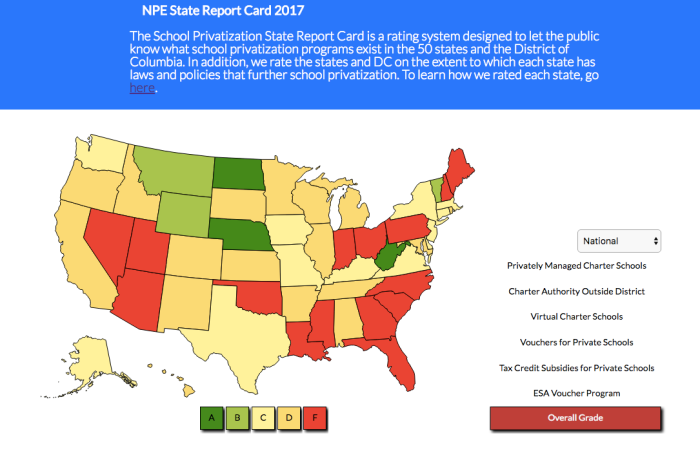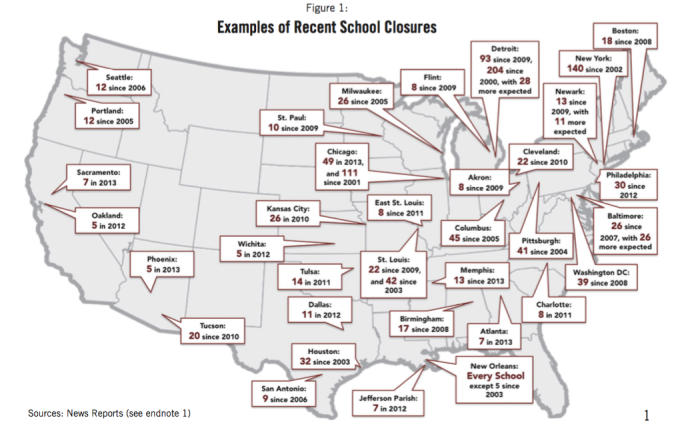The Network for Public Education has recently published the School Privatization Explained toolkit to educate the public on the harms of privatization and to encourage informed decision-making when approached with so-called solutions marketed in the name of “school choice.” The document includes two-page summary responses to each of the following questions:
Are charter schools truly public schools?
Do charter schools and school vouchers “hurt” public schools?
Do charter schools get better academic results than public schools?
Are charter schools and vouchers a civil rights cause?
Are charter schools “more accountable” than public schools?
Do charter schools profit from educating students?
Do school vouchers help kids in struggling schools?
Are charter schools innovative?
Are online charter schools good options for families?
Do “Education Savings Accounts” lead to better results for families?
Are tax credit scholarships a voucher by a different name?
Do charter schools and vouchers save money?
The toolkit also includes a combined version that includes all of the above summaries in a single document.
In addition to the written summaries, NPE includes interactive maps documenting the extent to which privatization policies have taken hold in each of the states, with six different versions depending on the criteria selected on the right below. To view the combined analysis, click the image below or here. To learn about the criteria used to rate the states, see here. 
___________________________________________________
Now, let’s connect the NPE maps to earlier efforts that document impacts of charter expansions on affected communities. Check out the map below from this 2014 report published by the Journey for Justice Alliance.
As can be seen in Figure 1, America’s predominantly Black and Latino communities are experiencing an epidemic of public school closures. For example:
- In New Orleans, beginning in the Fall of 2014, there will be only five public schools left in the entire city
- Detroit, New York, and Chicago have all had more than 100 public schools closed in recent years
- Columbus (OH), Pittsburgh, St. Louis, Houston, Philadelphia, Washington DC, Kansas City, Milwaukee, and Baltimore have all had more than 25 public schools closed in recent years.
- Many other urban districts – including numerous districts not pictured in Figure 1- have also experienced multiple school closures, particularly within the last few years. And there are many others in the works.”…Death By A Thousand Cuts: Racism, School Closures, and Public School Sabotage: Voices from America’s Affected Communities of Color
Note that the closures of public schools often translate to replacement with privately managed charters (see The School Closure Playbook and The Perfect Storm: Disenfranchised Communities for video documentaries of what happened in Chicago and New Orleans).
The map below adds an additional lens by documenting charter school closures from 2001 to 2013 (originally published by Center for Media and Democracy).
Given that there are currently about 6,800 charter schools in the U.S., the closures of over 2,200 charters during the bulk of the same growth era reveals an extraordinarily high failure rate. Such churn suggests unchecked growth of the sector to be an epic gamble at the expense of both students’ lives and taxpayer dollars. A recent report by In The Public Interest documents extensive evidence of loss, waste, and fraud within the California charter sector and highlights a number of problematic practices, including the use of public tax dollars to purchase private property. For readers interested in how related trends have been called out in the past, see: Ulterior Motives?: School “Reform”, Rich, Poor, and Land Grabs.
So, what to do? It’s up to you. Consider following more closely the unintended (or perhaps intended) consequences of charter growth and learn more about the roots of where pro-privatization messages are coming from. How do the trends intersect with pending legislation? And what’s the role of marketing in the new market-place of charter chains? There are many issues to consider, and the more informed (and engaged) the public can be on these matters, the better decisions we’ll all be able to make for children in our communities.
For more, see:
CyberCharters: Widespread Reports of Troubles // Education Week
Privatized Education Steals From the Poor, Gives to the Rich
How Online Learning Companies Bought America’s Public Schools // The Nation
How Hedge Funds Will Profit From School Privatization
Perfect Storm: The Takeover of New Orleans Schools: Disenfranchised Communities
Charter Schools & “Choice”: A Closer Look
NAACP Board Approves Resolution Calling for a Moratorium on Charter School Expansion





An amazing FAILURE rate exposed (“Given that there are currently about 6,800 charter schools in the U.S., the closures of over 2,200 charters during the bulk of the same growth era reveals an extraordinarily high failure rate”) and yet the push for more charters remains a priority in so many states. It feels surreal to live in a world where statistical truth is simply not relevant to political goals.
Pingback: An Electronic Silent Spring – May, 2017 Newsletter | Electronic Silent Spring
Pingback: Will California State Board of Education Ignore Red Flags in Charter School Appeal Decisions? | EduResearcher